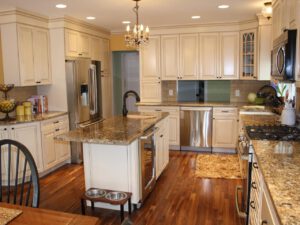Richmond Va Kitchen Remodeling is a big investment, so creating a budget is wise before starting. Pin inspiration from home improvement websites and consider talking to lighting, tile, and appliance store professionals for advice on what can be done within your budget.
Choose timeless designs and materials to hold up over time. Avoid over-customizing, which may limit your future home-buying audience.

Cabinets are one of any kitchen’s most important and most used elements. They offer storage and functional workspace but can also add style to the kitchen design. There are many different cabinets to choose from, and they can be repurposed in several ways. For example, old cabinets can be transformed into open shelving to display cookbooks and dishes. Or, they can be painted or stained to match the rest of the kitchen and add a pop of color.
Base cabinets are generally installed after the wall and floor surfaces are finished but before countertops and appliances are brought in. They are anchored to the subfloor or wall studs and are typically shimmed to ensure they are level.
Slab or flat-front cabinets are the most basic cabinet style and can be spiced up with a unique paint or stain color or by adding details such as oversized handles. They are easy to clean and look great in a minimalist kitchen design.
Countertops are one of the most demanding elements of a kitchen. The surface must be tough, durable (stain-proof and impact-resistant), and aesthetically appealing. Often, the choice of countertop material is driven by the design and lifestyle goals of the homeowners and what best complements the cabinetry and floors.
Granite is a popular option for countertops because it is both heat and stain-resistant and comes in various colors and visual textures. It must be sealed regularly.
Laminate is an inexpensive countertop option that’s easy for DIYers to install. Newer porcelain types offer diverse designs that mimic natural wood, real stone, and more. Tile is another good option that’s inexpensive, durable, and available in various patterns and colors. However, grout seams can crack and stain easily, requiring regular replacement.
Stainless steel countertops are another option. These are made on-site by forming a platform and cutting to field dimensions using a precise machine, usually located at the installer’s shop. The edges are rounded or ogee-shaped, and the finish may include an inlay.
Flooring is an essential component of a kitchen remodel, whether you are installing a new design or upgrading to a better material. It must be durable enough to stand up to traffic and spills, comfortable for long periods, and beautiful.
Tile is a popular option, with many choices in different colors, shapes, and sizes. Some types are designed to look like natural materials, such as stone, wood, or marble, while others can be highly patterned and modern. Cement tiles are another option, as they are highly textured and waterproof when glazed.
If you’re looking for something more unique, consider travertine tiles. This sedimentary rock is often used in bathrooms, but it’s also becoming a common choice for kitchen floors. Travertine is a neutral color that can be mixed with other hues or accentuated by patterns. It is available in muted tan tones and bold purple, orange, or red ribbons. Its organic beauty is sure to add a dramatic touch to your kitchen.
Lighting is an essential element of any kitchen remodel project. It can create the room’s ambiance, set the mood, and improve visibility for food preparation. There are several different types of light fixtures, each offering unique advantages. Choosing the right color temperature, wattage, and fixture placement is important in creating the desired ambiance while keeping a well-lit space.
A popular kitchen remodel idea is to add under-cabinet lighting. This can be in the form of all-in-one linear fixtures, modular pucks, or strip lights that can be connected in a process called daisy chaining. They can be hardwired to a switch or dimmer, plugged into an outlet, or powered by batteries.
Another great kitchen remodel idea is to light up your workspaces with task lighting. This can be done with recessed lights or pendants placed over sinks, standalone chopping stations, and dining areas. Avoid putting these lights directly above appliances, as this can create glare and be distracting when cooking.
Appliances greatly impact the layout and functionality of a kitchen, as well as how it looks. The refrigerator keeps perishables fresh, the microwave reheats leftovers, and the dishwasher cleans dishes and utensils.
Choosing new appliances with a style that matches performance is an important part of kitchen remodeling. Stainless steel finishes are popular, but you can find options that fit any taste or budget. Energy-efficient models reduce utility bills and help the environment by using less electricity.
If you plan on keeping your current appliances, store them in a garage or other room during the remodel so they don’t get damaged. Be sure to talk to your local appliance repair guy before making final decisions! Many high-end appliances come with warranties that include cosmetic repairs as well. These warranties can save you a lot of money in the long run. It’s also a good idea to choose panel-ready appliances to add a custom font to match your cabinetry. This gives you a timeless look that will stay in style quickly.
A kitchen remodel involves a lot of electrical work. It can include rewiring the entire space, adding or moving outlets and switches, and upgrading your breaker box to handle the added electrical load. If your old wiring can’t keep up, you risk having circuit breakers that frequently trip, or worse, the house could be at risk of fire and electrocution.
You also need to add new electrical circuits for your new appliances. You need one for the stove, another for the refrigerator, and at least two additional circuits for outlets where you’ll be using small appliances. A professional electrician will ensure that all new appliances and lights are wired safely, ensuring compliance with all applicable safety standards.
By strategically placing fixtures, you can add lighting to elevate your kitchen’s aesthetic and increase functionality. You can also incorporate smart home technology to promote your cooking experience and boost household efficiency. For example, you can install a power strip on the countertop that hides cords and provides multiple charging ports for your electronic devices.
Kitchen remodeling often involves plumbing. This can be a simple upgrade to the sink, faucets, or appliances or can be more significant and require rerouting plumbing lines. It might also involve new gas lines for a stove or oven.
Regardless of the size or scope of your remodel, good plumbers will be required to ensure all the work is done properly and safely. A bad plumber can cause many problems that are expensive to fix.
Upgrading old iron-style pipes to modern plumbing like PVC is a great investment during a kitchen remodel. It’s an easy way to reduce water bills, improve the look of your home, and make rerouting future installations easier. In addition, it’s an opportunity to get rid of those rusty pipes that could leak into your walls and cause costly damage. Replacing these with new pipes can be more cost-effective than repairing or replacing fixtures and appliances later. This is especially true if you’re planning to sell your home in the future.
Many kitchen remodeling projects require structural modifications. This can include removing load-bearing walls to create an open floor plan, adding an extension, or expanding the ceiling height. This type of work requires the help of a qualified structural engineer to ensure the integrity of your home remains unaffected.
Depending on the extent of the remodel, it may also be necessary to obtain building permits or perform structural alterations, such as relocating plumbing lines and electrical outlets. Working with a contractor who understands the local permit process and can provide the proper documentation for each job is important.
When choosing a contractor, look for one specializing in kitchen remodeling and with an extensive portfolio of projects in your desired style. Ask for referrals from personal and business contacts, and search online review sites for customer reviews and certifications. A professional and knowledgeable kitchen remodeler can help you identify your pain points and vision for the new space and develop a timeline that will make it possible to accomplish your project goals.


